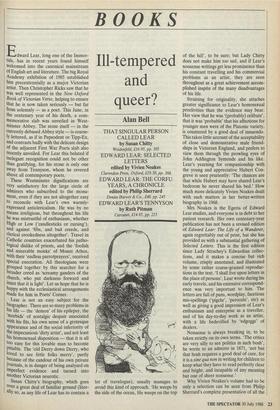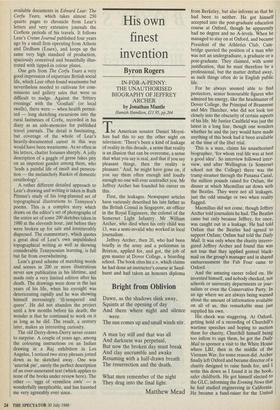BOOKS
Ill-tempered and queer?
Alan Bell
THAT SINGULAR PERSON CALLED LEAR by Susan Chitty
Weidenfeld, £16.95, pp. 305 Denise Harvey & Co., f40, pp. 245
EDWARD LEAR'S TENNYSON by Ruth Pitman Carcanet, £14.95, pp. 215 Edward Lear, long one of the Immor- tals, has in recent years found himself welcomed into the canonical mainstream of English art and literature. The big Royal Academy exhibition of 1985 established him precentennially as a major Victorian artist. Then Christopher Ricks saw that he was well represented in the New Oxford Book of Victorian Verse, helping to ensure that he is now taken seriously — but far from solemnly — as a poet. This June, in the centenary year of his death, a com- memorative slab was unveiled in West- minster Abbey. The stone itself — in the currently debased Abbey style — is coarse- ly lettered, as if in Pepsodent or Tipp-Ex, and contrasts badly with the delicate design of the adjacent First War Poets slab also recently unveiled. For Lear this belated if inelegant recognition could not be other than gratifying, for his stone is only one away from Tennyson, whom he revered above all contemporary poets.
These Westminster dignifications are very satisfactory for the large circle of admirers who subscribed to the monu- ment, even if they are not altogether easy to reconcile with Lear's own warmly- expressed anticlericalism. He was by no Means irreligious, but throughout his life he was mistrustful of enthusiasm, whether High or Low (`candlesticks or cursing'), and against 'fibs, and bad creeds, and clerical crookedness altogether'. Travel in Catholic countries exacerbated his patho- logical dislike of priests, and the 'foolish and miserable monks' of Mount Athos, with their 'endless parrotprayers', received special execration. All theologians were grouped together by this searcher for a broader creed as `screamy ganders of the church, who put darkness forward and insist that it is light'. Let us hope that he is happy with the ecclesiastical arrangements made for him in Poets' Corner.
Lear is not an easy subject for the biographer. There are so many problems in his life — the 'demon' of his epilepsy, the morbids' of nostalgic despair associated with his fits, his own sense of a grotesque appearance and of the social inferiority of the impecunious 'dirty artist', and not least his homosexual disposition — that it is all too easy for this lovable man to become pitiable. The 'old Derry down Derry, who loved to see little folks merry', partly because of the candour of his own private journals, is in danger of being analysed on imperfect evidence and turned into another Victorian neurotic.
Susan Chitty's biography, which goes over a great deal of familiar ground (liter- ally so, as any life of Lear has to contain a lot of travelogue), usually manages to avoid this kind of approach. 'He weeps by the side of the ocean, He weeps on the top of the hill', to be sure; but Lady Chitty does not make him too sad, and if Lear's nonsense writings get less prominence than his constant travelling and his commercial problems as an artist, they are seen throughout as a great achievement accom- plished inspite of the many disadvantages of his life.
Straining for originality, she attaches greater significance to Lear's homosexual proclivities than the evidence may bear. Her view that he was `(probably) celibate', that it was 'probable' that his affections for younger men were of the Platonic variety, is countered by a good deal of innuendo. This takes little account of the acceptability of close and demonstrative male friend- ships in Victorian England, and prefers to view them through the prowling eyes of John Addington Symonds and his like. Lear's yearning for companionship with the young and appreciative Hubert Con- greve is seen pruriently: 'The chances are that while Hubert may have shared Lear's bedroom he never shared his bed.' How much more delicately Vivien Noakes dealt with such matters in her better-written biography in 1968.
Mrs Noakes is the Egeria of Edward Lear studies, and everyone is in debt to her patient research. Her own centenary-year publication has not been a revised edition of Edward Lear: The Life of a Wanderer, again regrettably out of print, but she has provided us with a substantial gathering of Selected Letters. This is the first edition since Lady Strachey's Edwardian collec- tions, and it makes a concise but rich volume, crisply annotated, and illustrated by some rather coarse-grained reproduc- tions in the text. 'I shall live upon letters in the place of persons', Lear wrote during his early travels, and his extensive correspond- ence was very important to him. The letters are full of puns, wordplay, facetious mis-spellings (`pigche, `peroozle', etc) as well as giving a good impression of Lear's enthusiasm and enterprise as a traveller, and of his day-to-day work as an artist, with a life bedevilled by `edgoggs' of dealers.
Nonsense is always breaking in, to be taken strictly on its own terms. 'The critics are very silly to see politics in such bosh', he wrote to an admirer in 1871, 'not but that bosh requires a good deal of care, for it is a sine qua non in writing for children to keep what they have to read perfectly clear and bright, and incapable of any meaning but one of sheer nonsense.'
Why Vivien Noakes's volume had to be only a selection can be seen from Philip Sherrard's complete presentation of all the available documents in Edward Lear: The Corfu Years, which takes almost 250 quarto pages to chronicle from Lear's letters and very extensive journals the Corfiote periods of his travels. It follows Lear's Cretan Journal published four years ago by a small firm operating from Athens and Dedham (Essex), and keeps up the same very high standard of production, spaciously conceived and beautifully illus- trated with tipped-in colour plates.
One gets from The Corfu Years a very good impression of expatriate British social life, which Lear often found wearisome but nevertheless needed to cultivate for com- missions and gallery sales that were so difficult to nudge. Against the 'frittery evenings' with the `Gonfiati' (or local swells), there were — when health permit- ted — long sketching excursions into the rural fastnesses of Corfu, recorded in his diary as an aide-memoire for published travel journals. The detail is fascinating, but coverage of the whole of Lear's heavily-documented career in this way would have been wearisome. As so often in his letters, chatter focusses sharply. A jolly description of a gaggle of geese takes pity on an impotent gander among them, who `leads a painful life of insult and persecu- tion — the melancholy Ruskin of domestic ornithology'.
A rather different detailed approach to Lear's drawing and writing is taken in Ruth Pitman's study of his long-planned set of topographical illustrations to Tennyson's poems. This is a complex story which draws on the editor's set of photographs of the entire set of some 200 sketches taken in 1980 at the eleventh hour, just before they were broken up for sale and irretrievably dispersed. The commentary, which quotes a great deal of Lear's own unpublished topographical writing as well as showing considerable Tennysonian learning, is full but far from overwhelming.
Lear's grand scheme of matching words and scenes in 200 or more illustrations never saw publication in his lifetime, and made only a very limited edition after his death. The drawings were done in the last years of his life, when his eyesight was deteriorating rapidly and he was showing himself increasingly 'ill-tempered and queer'. He did not abandon the project until a few months before his death; the wonder is that he continued to work on it as long as he did. The result, a century later, makes an interesting curiosity.
The old Derry-down-Derry never ceases to surprise. A couple of years ago, among the colouring instructions on an Indian drawing in a Raj exhibition in Los Angeles, I noticed two stray phrases jotted down as he sketched away. One was `asterisk pie', surely the perfect description of an over-annotated text (which applies to none of the books under review here). The other — 'eggs of vermilion owls' — is wonderfully inexplicable, and has haunted me very agreeably ever since.















































 Previous page
Previous page